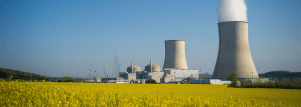By Greg Witt, GMU Biodefense PhD student
Greg worked as a senior nuclear systems engineer at Westinghouse Electric Company from 2010 to 2017. He served as the design lead for the AP1000® nuclear power plant’s reactor system and reactor coolant system.
On November 14, the Schar School’s Center for Security Policy Studies and Biodefense Graduate program hosted an event at George Mason University’s Arlington campus to examine the role that nuclear energy can play in helping the world achieve a low-carbon future without threatening nuclear security. The event featured two noteworthy guest speakers: Dr. Mikhail Chudakov, International Atomic Energy Agency (IAEA) Deputy Director General and Head of the Department of Nuclear Energy, and Dr. Brent Park, Deputy Administrator for Defense Nuclear Nonproliferation at the National Nuclear Security Administration (NNSA). Dr. Chudakov delivered the keynote speech at the event, entitled “IAEA Assistance for a Sustainable Energy Future.” In this presentation, he outlined his assessment of the present and future landscape of energy supply and demand, as well as his vision for the role that nuclear power could play in creating a more sustainable, equitable future.
Despite the plentiful and relatively cheap energy available in the upper-income countries, nearly 1 billion people worldwide have no consistent access to electricity, with another 1 billion having reduced access to healthcare due to energy poverty and a further 2.7 billion relying on biomass as their primary source of energy. Any program hoping to ameliorate these challenges would almost certainly require a radical expansion in global electricity generation, a development that until now has mostly relied on the increased extraction and burning of fossil fuels, such as coal and petroleum. This has had predictably dire consequences over both the short term, generating air pollution, and the long term, contributing to climate change, which disproportionately impacts vulnerable populations in lower- and middle-income countries.
To bring global electricity supply in line with this ever-growing demand while simultaneously addressing the climate crisis requires a massive, international investment in energy production from sources other than fossil fuels. By 2050, over 90% of electricity must come from low-carbon sources to limit warming to 1.5°C over the next century, a condition necessary to meet the more ambitious targets set by the Paris Agreement under the United Nations Framework Convention on Climate Change. While renewable energy sources, including solar, wind, and hydroelectric power, will inevitably play a role in any low-carbon future, Dr. Chudakov asserted that any genuinely sustainable energy future would also require a massive investment in nuclear energy due to its scalability, high capacity factor, and the abundance of available fuel. He pointed out that 86 out of the 90 plausible mitigation pathways developed by the Intergovernmental Panel on Climate Change (IPCC) for keeping total warming below 1.5°C rely, to some degree, on maintaining or expanding global nuclear capacity.
A significant amount of nuclear infrastructure already exists around the world today, with 450 nuclear power plants currently in operation possessing a total capacity of nearly 400 Gigawatts electrical (GWe), and another 52 plants under construction. In terms of electricity production, around one-third of all low-carbon energy produced today comes from nuclear energy. Several new and experimental technologies, such as small modular reactors (SMRs) and fuel that can survive for extended periods under severe accident conditions, hold the potential to make nuclear power safer and more accessible. Nuclear fusion, which poses no proliferation risk and generates virtually no radioactive waste, remains the holy grail of energy research, but fusion reactors are not expected to be capable of consistently generating more energy than they consume until at least 2030, with commercial viability even further in the future.
To help bring about this low-carbon future powered by nuclear energy, the IAEA is running a number of initiatives to assist member states interested in pursuing peaceful fission power without posing a risk to the international nonproliferation regime. The agency has conducted 29 Integrated Nuclear Infrastructure Review (INIR) missions in 21 member states, helping lower- and middle-income countries develop the initial infrastructure needed to support the construction of nuclear plants. To maintain global nuclear capacity for the foreseeable future, the IAEA is supporting efforts to extend the effective lifespan of existing plants until they can be replaced or supplemented by new reactors. Since nuclear knowledge management is essential to retaining tacit knowledge in the nuclear industry and building expertise in nations without prior experience in the field, the agency has developed the International Nuclear Information System to serve as a repository for 4.2 million files and engaged in Coordinated Research Projects involving 1,600 research institutions. Finally, it is involved in nonproliferation efforts such as a push to downblend highly enriched uranium (HEU) into low enriched uranium (LEU) and operating a LEU bank in Kazakhstan to supply countries with fuel without the need for domestic enrichment.
During the question and answer session, moderated by GMU associate professor and Biodefense program director Dr. Gregory Koblentz, Dr. Chudakov and Dr. Park responded to several questions from the audience related to nuclear energy and nuclear security. As a veteran of the Soviet nuclear industry during the 1980s, Dr. Chudakov acknowledged the role that public perceptions of nuclear power, in particular political opposition and safety concerns following the disasters at Chernobyl and Fukushima, have played in stopping the construction of new plants. However, he countered that the death tolls from even the worst nuclear accidents were dwarfed by the suffering caused by fossil fuel air pollution, let alone from the long-term impact of carbon emissions. Dr. Park fielded questions related to the problematic trade-offs between expanding access to nuclear energy and preventing the spread of nuclear weapons. He pointed to ongoing efforts to design proliferation-resistant fuels but acknowledged that the technical side of nonproliferation is only half the battle.
Image courtesy of Guillaume Souvant / AFP / Getty Images

2 thoughts on “Event Summary: The Nexus Between Nuclear Energy & Nuclear Security”